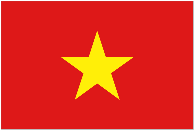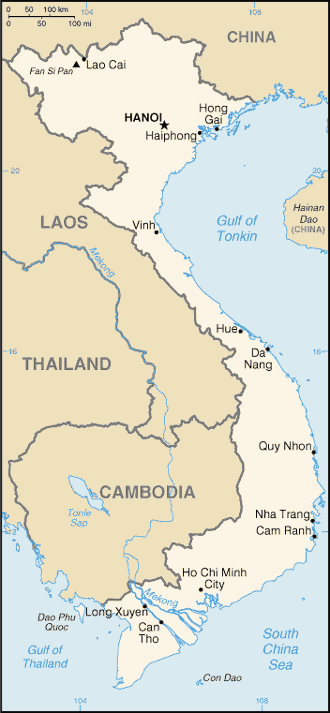Table of Contents
| Location and Size | Credit and Collections |
| Government | Risk Assessment |
| Legal System | Business Climate |
| People | Business Protocol |
| Economy | |
| Comparative Indicators |
12345
Location and Size
Vietnam is located in Southeastern Asia, bordering the Gulf of Thailand, Gulf of Tonkin, and the South China Sea. Adjacent countries include China, Laos, and Cambodia. Vietnam’s total land area is 310,070 sq. km., making the country slightly larger than New Mexico in the United States.
Government
The Vietnamese government is a communist state.
Branches:
- Executive: Chief of State: President Nguyen Phuc; Vice President: Vo Thi Anh Xuan; Head of government: Prime Minister: Pham Minh Chinh.
- Legislative: Unicameral National Assembly (493 seats) elected by popular vote to serve five-year terms.
- Judicial: Supreme People’s Court (Chief justice is elected by the National Assembly on the recommendation of the president for a five-year term).
Legal System
Vietnam’s legal system is based on communist legal theory and the French civil law system. Vietnam has not accepted compulsory International Court of Justice (ICJ) jurisdiction.
There is evidence that court judgments on business-related issues are often ignored when the affected party can use informal channels of influence (such as bribes) to prevent the enforcement of the judgment. According to KPMG and the Economist Intelligence Unit, the legal system is loaded with conflict and overlap, which in many instances provides opportunities for corruption. Heritage Foundation 2010 further states that due to widespread corruption in the judiciary, contracts are weakly enforced.
People
- Population: 98,186,856 (2022 )
- Population growth rate: .75% (2022)
- Languages: Vietnamese (official), English, Khmer, other indigenous languages
- Literacy: 94.2% (2022 est.)
- Ethnic Make-up: Kinh (Viet) (85.3%), Tay (1.9%), Thai (1.9%), Muong (1.5%), Khmer (1.4%), Mong (1.4%), Nung (1.1%), other (5.5%)
- Religions: Catholic (6.1%), Buddhist (5.8%), Protestant (1%), other (0.8%), none (86.3%)
*most Vietnamese are culturally Buddhist and approximately 45% practice a “folk religion” (identified with Confucianism and Taoism)
Economy
Vietnam is a densely populated, developing country that in the last 30 years has had to recover from the ravages of war, the loss of financial support from the old Soviet Bloc, and the rigidities of a centrally planned economy.
Following the reunification of North and South Vietnam, the country experienced a period of economic stagnation. Since that time, however, market reforms have been introduced that opened up the country for foreign investment and have dramatically improved Vietnam’s business climate.
Leading Markets (2022): US 20.1%, China 14.5%, Japan 8.0%, South Korea 6.8%
Leading Exports – Commodities: crude oil, marine products, rice, coffee, rubber, tea, garments, shoes
Leading Suppliers (2022): China 25.8%, South Korea 20.5%, Japan 7.8%, Thailand 4.9%
Leading Imports – Commodities: Machinery and equipment, petroleum products, fertilizer, steel products, raw cotton, grain, cement, motorcycles
Top Industries: Food processing, garments, shoes, machine building; mining, coal, steel; cement, chemical fertilizer, glass, tires, oil, paper
Top Agricultural Products: Paddy rice, coffee, rubber, cotton, tea, pepper, soybeans, cashews, sugar cane, peanuts, bananas; poultry; fish, seafood
Comparative Economic Indicators – 2023
| Vietnam | Cambodia | China | Laos | Thailand | U.S. | ||
| Population* (millions) | 89.6 | 16.4 | 1,384.6 | 7.2 | 68.6 | 331.9 | |
| Population growth rate* (%) | 1.1 | 1.48 | 0.37 | 1.48 | 0.29 | 0.1 | |
| Literacy | 90.3 | 80.5 | 96.4 | 84.7 | 92.7 | 99.0 | |
| Unemployment rate (%) | 6.5 | 0.3 | 3.9 | 18.2 | 0.7 | 3.5 | |
| Inflation (%) | 7.0 | 2.9 | 1.6 | 0.8 | 0.7 | 2.1 | |
| Population below poverty line (%) | 12.3 | 16.5 | 3.3 | 22.0 | 7.2 | 15.1 | |
| GDP** (USD billions) | 258.1 | 64.2 | 23,200.1 | 49.34 | 1,236.0 | 23,320.0 | |
| GDP real growth rate (%) | 5.3 | 6.9 | 6.9 | 6.9 | 3.9 | 2.2 | |
| Public debt (% of GDP) | 53.7 | 30.4 | 47.0 | 63.6 | 41.9 | 78.8 | |
| Foreign debt (% of GDP) | 37.4 | 18.0 | 6.8 | 30.1 | 10.6 | 91.8 | |
| Exports (USD billions) | 214.1 | 11.4 | 2,216.0 | 3.6 | 235.1 | 1,553.0 | |
| Imports (USD billions) | 202.6 | 14.37 | 1,740.0 | 4.9 | 203.2 | 2,361.0 | |
| Currency | Dong
VND |
Riel
KHR |
Yuan Renminbi
CNY |
Kip
LAK |
Thai
BHT |
Dollar
USD |
|
| Exchange rates (per USD) 01/17/2023 |
23,450.00 | 4,105.17 | 6.73 | 16,868.64 | 33.09 | n/a | |
|
Exchange rates (per EUR)
01/17/2023 |
25,267.86 | 4,440.91 | 7.28 | 18,248.16 | 35.80 | 1.08 | |
Economic Data from CIA World Factbook
Credit and Collections
Vietnam’s legal system, including its dispute and claims settlement mechanisms, remains underdeveloped and ineffective. Negotiation between the concerned parties is the most common and preferred means of dispute resolution.
Vietnam is a party to the New York Convention on the Recognition and Enforcement of Foreign Arbitral Awards. Foreign and domestic arbitral awards are legally enforceable in Vietnam.
Risk Assessment
Coface Country Rating: B — Political and economic uncertainties and an occasionally difficult business environment can affect corporate payment behavior. Corporate default probability is appreciable.
Coface Business Climate Rating: B — A very uncertain political and economic outlook and a business environment with many troublesome weaknesses can have a significant impact on corporate payment behavior.
Business Climate
The Communist Party continues to exercise complete control over political, economic, and social life in Vietnam, and the government still holds a tight rein over major sectors of the economy through large state-owned economic groups and enterprises and much of the banking system.
Vietnam is in a phase of transition from a centrally planned economy to a ‘market economy with socialist orientation’. The government has plans to reform key sectors and partially privatize state-owned enterprises, but implementation has been gradual and the state sector still accounts for approximately 36% of GDP.
Transparency of Regulatory System: In recent years, Vietnam has improved its process for making and publicizing laws, particularly major national laws and regulations. Substantial foreign assistance continues to be provided to assist Vietnam’s efforts to establish a legal structure compatible with international standards.
Intellectual Property Rights: Vietnam has joined the Paris Convention on Industrial Property and the Berne Convention on Copyright, and has worked to meet its commitments under these international treaties. Although Vietnam has made progress in establishing a legal framework for IPR protection, various forms of infringement and piracy of intellectual property continues to be widespread.
Enforcement of administrative orders and court decisions on IPR issues remains inconsistent and weak. In addition, the system of administrative enforcement is complex and rights holders have raised concerns regarding inconsistent coordination among enforcement agencies.
Conversion and Transfer Policies: Foreign businesses are permitted to remit profits in hard currency. All currency transactions between residents and non-residents of Vietnam are conducted freely.
Economic Freedom: Vietnam’s economic freedom score is 60.6, making its economy the 84th freest according to the 2022 Heritage Index of Economic Freedom. Vietnam is ranked 18th out of 39 countries in the Asia Pacific region, and its overall score is lower than the world and regional averages.
Corruption: Corruption is rampant throughout Vietnam and permeates the activities of the many state companies that still dominate the economy’s strategic sectors. In order to attract foreign investment, the government is attempting to combat corruption, and the legal framework for doing so is now in place. However, even though Vietnam has one of the most comprehensive anti-corruption laws in Asia, implementation and lack of independent anti-corruption agencies still pose a major weakness in reducing corruption.
Political Violence: There have been no recent incidents of violence against investors in Vietnam.
Business Protocol
As with many other Asian nations, the concept of face is extremely important to the Vietnamese. Face is a quality that reflects a person’s (or company’s) reputation, dignity, and prestige. Foreigners may unintentionally cause a loss of face. It is important, therefore, that they are consistently aware of their words and actions. Understanding how face is lost, saved, or given is critical to forming business relationships. Source: vietnam-briefing.com
**********
Subscribe to the Credit-to-Cash Advisor
Monthly e-Newsletter — It’s Free
This information is provided by ABC-Amega Inc. Providing international receivable management and debt collection services for exporters to more than 200 countries. For further information, contact [email protected].
Historical Exchange Rates: OANDA.com The Currency Site.

